
 Copyright 2019 by Rockridge Press, Emeryville, California No part of this publication may be reproduced, stored in a retrieval system, or transmitted in any form or by any means, electronic, mechanical, photocopying, recording, scanning, or otherwise, except as permitted under Sections 107 or 108 of the 1976 United States Copyright Act, without the prior written permission of the Publisher. Requests to the Publisher for permission should be addressed to the Permissions Department, Rockridge Press, 6005 Shellmound Street, Suite 175, Emeryville CA 94608. Limit of Liability/Disclaimer of Warranty: The Publisher and the author make no representations or warranties with respect to the accuracy or completeness of the contents of this work and specifically disclaim all warranties, including without limitation warranties of fitness for a particular purpose. No warranty may be created or extended by sales or promotional materials. The advice and strategies contained herein may not be suitable for every situation. This work is sold with the understanding that the Publisher is not engaged in rendering medical, legal, or other professional advice or services.
Copyright 2019 by Rockridge Press, Emeryville, California No part of this publication may be reproduced, stored in a retrieval system, or transmitted in any form or by any means, electronic, mechanical, photocopying, recording, scanning, or otherwise, except as permitted under Sections 107 or 108 of the 1976 United States Copyright Act, without the prior written permission of the Publisher. Requests to the Publisher for permission should be addressed to the Permissions Department, Rockridge Press, 6005 Shellmound Street, Suite 175, Emeryville CA 94608. Limit of Liability/Disclaimer of Warranty: The Publisher and the author make no representations or warranties with respect to the accuracy or completeness of the contents of this work and specifically disclaim all warranties, including without limitation warranties of fitness for a particular purpose. No warranty may be created or extended by sales or promotional materials. The advice and strategies contained herein may not be suitable for every situation. This work is sold with the understanding that the Publisher is not engaged in rendering medical, legal, or other professional advice or services.
If professional assistance is required, the services of a competent professional person should be sought. Neither the Publisher nor the author shall be liable for damages arising herefrom. The fact that an individual, organization, or website is referred to in this work as a citation and/or potential source of further information does not mean that the author or the Publisher endorses the information the individual, organization, or website may provide or recommendations they/it may make. Further, readers should be aware that websites listed in this work may have changed or disappeared between when this work was written and when it is read. For general information on our other products and services or to obtain technical support, please contact our Customer Care Department within the United States at (866) 744-2665, or outside the United States at (510) 253-0500. Rockridge Press publishes its books in a variety of electronic and print formats.
Some content that appears in print may not be available in electronic books, and vice versa. TRADEMARKS: Rockridge Press and the Rockridge Press logo are trademarks or registered trademarks of Callisto Media Inc. and/or its affiliates, in the United States and other countries, and may not be used without written permission. All other trademarks are the property of their respective owners. Rockridge Press is not associated with any product or vendor mentioned in this book. Interior and Designer: William Mack Art Manager: Karen Beard Editor: Lia Brown Production Editor: Erum Khan Photography 2019 Marija Vidal.
Food styling by Cregg Green. ISBN: Print 978-1-64152-419-3 | eBook 978-1-64152-420-9 To my nephewsJay, Beck, and Vaughnwho will someday be going to college and maybe (hopefully) will want to learn how to cook vegan food for themselves. Contents Youre already ahead of where I was when I went away to school and had to start cooking for myself. If youre reading this book, youre obviously interested in going vegan or at least making some plant-based meals. Or maybe youve been vegan for a while but need to learn to cook for yourself because youre leaving home for college. When I started school, I was in residence my first year, on a meal plan, and I wasnt vegan at the time. I ate a lot of bagels with peanut butter, chili, pasta with plain tomato sauce, and chicken noodle soup.
Contents Youre already ahead of where I was when I went away to school and had to start cooking for myself. If youre reading this book, youre obviously interested in going vegan or at least making some plant-based meals. Or maybe youve been vegan for a while but need to learn to cook for yourself because youre leaving home for college. When I started school, I was in residence my first year, on a meal plan, and I wasnt vegan at the time. I ate a lot of bagels with peanut butter, chili, pasta with plain tomato sauce, and chicken noodle soup.
Those were pretty much the only things I would eat in the cafeteria because the rest of it didnt look appealing to me after my moms wonderful home-cooked meals. When I moved off campus into a house with two friends, I had to figure out how to cook for myself because I certainly couldnt afford take-out. My grocery shopping trips were an adventure on my Rollerblades with a backpack because I didnt have a car. Side note: Bring shoes if you do this because stores dont usually let you roll around, although that would be hugely efficient. With a full course load, a part-time job, flight training, and trying to fit in some exercise, there wasnt much time to cook anything fancy. My mainstays were incredibly boring compared to the recipes Ive put together for you here.
My housemate from college has tried some of these recipes, and she keeps asking me why I never cooked like this back then! The truth is, I hadnt yet made the connection between what I was eating and how I felt or between how our food is produced and the impact to our environment, and I hadnt learned how much cruelty animals are subjected to. Even though I never liked the idea of killing animals for food, I didnt question it hard enough. I also had very simple tastes, and I didnt like the same flavors I do now. Initially, my shift to vegetarian and then vegan was driven by newfound knowledge of animal agriculture's environmental impact. After going vegan, I noticed I had more energy, a clearer head, better digestion, and clear skin. I went back to school to become a Certified Holistic Nutritionist because I wanted to share how to be totally healthy and energized from plants.
And as I started experimenting with new foods and new flavors, and then taking cooking classes, my taste buds developed.  My goal with this book is to share what I wish someone had taught me when I was in college: how to make delicious, wholesome vegan meals that dont take forever. There are recipes here for familiar classics and basics to get you started, but also some recipes that encourage you to branch out and work with more flavors and cooking techniques. And you know what? They really dont take much longer than the boring stuff I was making when I was in school. Seeyoure already ahead of me.
My goal with this book is to share what I wish someone had taught me when I was in college: how to make delicious, wholesome vegan meals that dont take forever. There are recipes here for familiar classics and basics to get you started, but also some recipes that encourage you to branch out and work with more flavors and cooking techniques. And you know what? They really dont take much longer than the boring stuff I was making when I was in school. Seeyoure already ahead of me.  Eating vegan in college doesnt have to be challenging or expensive.
Eating vegan in college doesnt have to be challenging or expensive.
In fact, some of the most expensive items in a regular grocery cart are meat, eggs, and dairy. While you can easily go vegan with packaged meat alternatives, like premade burgers and burritos, they do cost a fair bit if you rely on them all the time. Instead, make delicious meals with whole grains and beans for a lower-budget food billand a more balanced diet. Lets Talk Vegan First, lets look at some basics youll need for your plant-based lifestyle, and then well dive in to the recipes. If you already have a fully stocked pantry and a fridge full of fresh food and know how to work in the kitchen, skip right ahead! So, what do vegans eat? We eat grains, beans, legumes, nuts, seeds, vegetables, fruits, spices, and herbs. That includes bread, pasta, hummus, peanut butter, French fries, and lots of foods that most people eat all the time and dont think about being vegan. KEY NUTRIENTS FOR VEGANSPROTEIN beans and legumes leafy greens legumes nuts quinoa seeds whole grains IRON cashews chickpeas leafy greens (spinach, beet greens, parsley) lentils and other beans molasses sesame seeds sunflower seeds quinoa CALCIUM
Next page
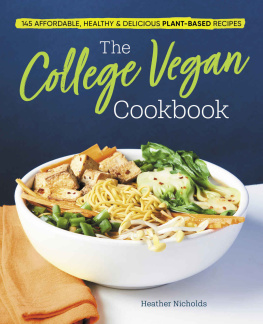


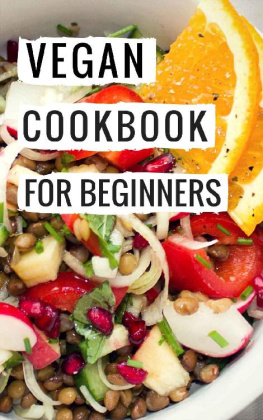

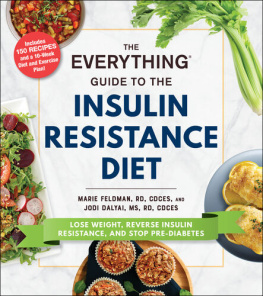

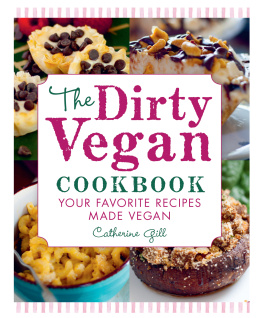
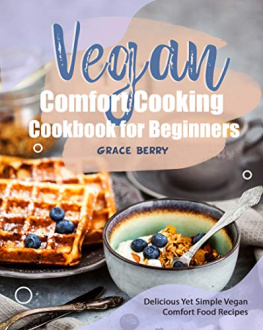
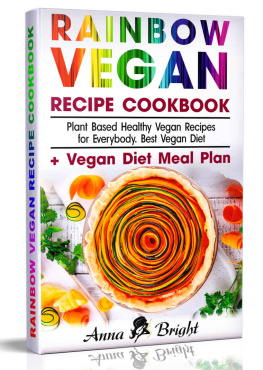
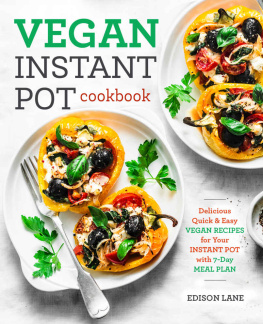

 Copyright 2019 by Rockridge Press, Emeryville, California No part of this publication may be reproduced, stored in a retrieval system, or transmitted in any form or by any means, electronic, mechanical, photocopying, recording, scanning, or otherwise, except as permitted under Sections 107 or 108 of the 1976 United States Copyright Act, without the prior written permission of the Publisher. Requests to the Publisher for permission should be addressed to the Permissions Department, Rockridge Press, 6005 Shellmound Street, Suite 175, Emeryville CA 94608. Limit of Liability/Disclaimer of Warranty: The Publisher and the author make no representations or warranties with respect to the accuracy or completeness of the contents of this work and specifically disclaim all warranties, including without limitation warranties of fitness for a particular purpose. No warranty may be created or extended by sales or promotional materials. The advice and strategies contained herein may not be suitable for every situation. This work is sold with the understanding that the Publisher is not engaged in rendering medical, legal, or other professional advice or services.
Copyright 2019 by Rockridge Press, Emeryville, California No part of this publication may be reproduced, stored in a retrieval system, or transmitted in any form or by any means, electronic, mechanical, photocopying, recording, scanning, or otherwise, except as permitted under Sections 107 or 108 of the 1976 United States Copyright Act, without the prior written permission of the Publisher. Requests to the Publisher for permission should be addressed to the Permissions Department, Rockridge Press, 6005 Shellmound Street, Suite 175, Emeryville CA 94608. Limit of Liability/Disclaimer of Warranty: The Publisher and the author make no representations or warranties with respect to the accuracy or completeness of the contents of this work and specifically disclaim all warranties, including without limitation warranties of fitness for a particular purpose. No warranty may be created or extended by sales or promotional materials. The advice and strategies contained herein may not be suitable for every situation. This work is sold with the understanding that the Publisher is not engaged in rendering medical, legal, or other professional advice or services. Contents Youre already ahead of where I was when I went away to school and had to start cooking for myself. If youre reading this book, youre obviously interested in going vegan or at least making some plant-based meals. Or maybe youve been vegan for a while but need to learn to cook for yourself because youre leaving home for college. When I started school, I was in residence my first year, on a meal plan, and I wasnt vegan at the time. I ate a lot of bagels with peanut butter, chili, pasta with plain tomato sauce, and chicken noodle soup.
Contents Youre already ahead of where I was when I went away to school and had to start cooking for myself. If youre reading this book, youre obviously interested in going vegan or at least making some plant-based meals. Or maybe youve been vegan for a while but need to learn to cook for yourself because youre leaving home for college. When I started school, I was in residence my first year, on a meal plan, and I wasnt vegan at the time. I ate a lot of bagels with peanut butter, chili, pasta with plain tomato sauce, and chicken noodle soup. My goal with this book is to share what I wish someone had taught me when I was in college: how to make delicious, wholesome vegan meals that dont take forever. There are recipes here for familiar classics and basics to get you started, but also some recipes that encourage you to branch out and work with more flavors and cooking techniques. And you know what? They really dont take much longer than the boring stuff I was making when I was in school. Seeyoure already ahead of me.
My goal with this book is to share what I wish someone had taught me when I was in college: how to make delicious, wholesome vegan meals that dont take forever. There are recipes here for familiar classics and basics to get you started, but also some recipes that encourage you to branch out and work with more flavors and cooking techniques. And you know what? They really dont take much longer than the boring stuff I was making when I was in school. Seeyoure already ahead of me.  Eating vegan in college doesnt have to be challenging or expensive.
Eating vegan in college doesnt have to be challenging or expensive.